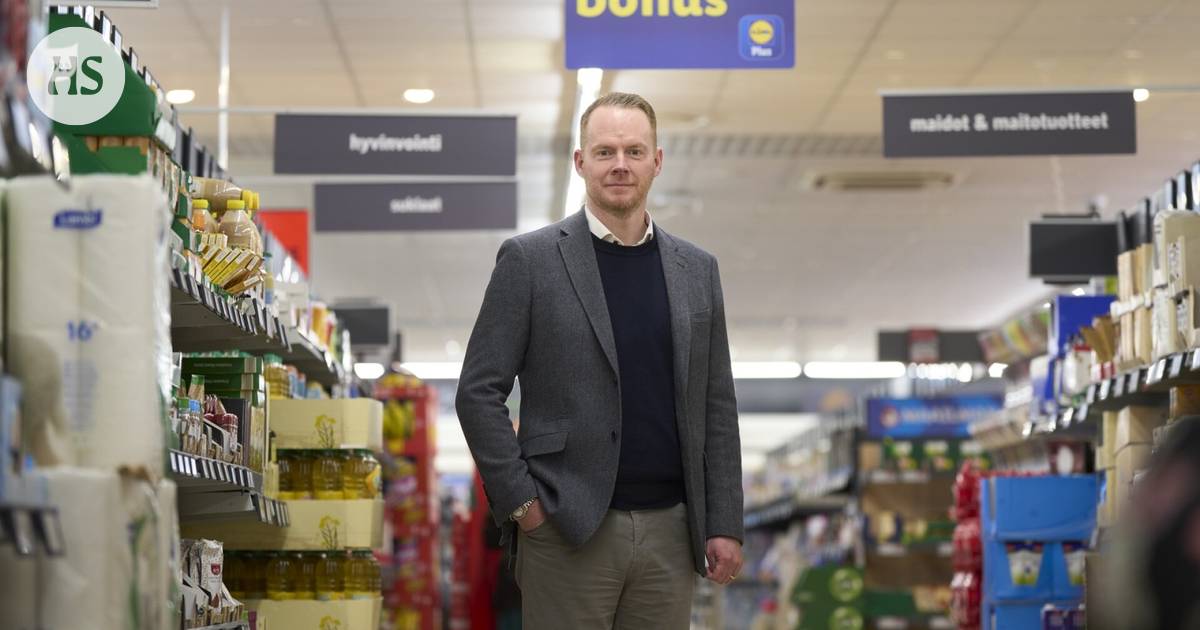The price of food|Lidl claims that rival hypermarkets have strange price fluctuations. This is how the S and K groups respond.
Read the summary
The summary is made by artificial intelligence and checked by a human.
Lidl’s Conor Boyle criticizes the price fluctuations of S and K chains in stores of the same chain.
HOK-Elanton’s Lassi Juntunen explains the variation in prices based on the local competitive situation.
K group’s Harri Hellman emphasizes the role of independent traders in pricing.
Two nearby hypermarkets, two completely different prices for the same affordable coffee package.
At Prisma in Itäkeskus, Helsinki, an Xtra coffee package costs 1.15 euros, but a few kilometers away at Prisma in Viikki it costs 2.59 euros.
What is this business, asks the managing director of the competing chain Lidl Finland Conor Boyle.
Lidl looked at certain cheap products from S and K chain hypermarkets. According to the chain, the same products have different prices in several adjacent stores. It claims to have found significant differences in both the capital region and the provinces.
Boyle takes as a price example the tofu offer of Jumbo and Iso Omena in the capital region, where you can get a certain package from K-Citymarket for 99 cents.
“But in Malmi and Columbus, consumers pay about 70 percent more for tofu.”
Also At Lidl itself, prices vary somewhat between stores.
The chain explains this by saying that it strives to be the cheapest, so a close competitor’s price cut is reflected in Lidl’s price tag.
“In certain of our stores, Iso Omena as one example, Lidl’s tofu product is priced differently than in other stores,” says Boyle.
“Quite frankly, those prices are not sustainable for us or our competitors.”
The cash desk of Helsinki’s Triplan Prisma pictured in August.
In the capital region Prismat of the S group belongs to the regional cooperative HOK-Elanto.
HOK-Elanto branch manager Lassi Juntunen does not comment on the prices of individual S group products or sales locations, but says that the stores are constantly monitoring what is happening in the surrounding area.
“We have national chain prices, but each store locally monitors the competitive situation in its own environment, shopper or market area and reacts as needed,” says Juntunen.
“We have never said that the prices of all products are the same everywhere all the time, but we have a sales promise that Prisma is as cheap as the cheapest. That’s what we redeem. It can cause that in some different situations [eri myymälöiden] prices may differ from each other.”
Such places are, for example, shopping centers where many chains are fighting for the same customers.
“However, under no circumstances do we engage in so-called cream peeling. It’s not a situation where ‘now is a nice place to raise prices’, but we have the chain price of Prismas at the bottom.”
Juntunen criticizes Lidl for the lack of transparency in pricing.
“The prices of all our grocery products for each store can be seen online at all times. We’re not hiding anything. Instead, you can’t find Lidl’s prices.”
A view of Ison Omena’s K-Citymarket.
K groupN in hypermarkets, pricing varies because each grocery store is responsible for an independent merchant.
Selection manager Harri Hellman comments that the merchant’s decisions are influenced by the size of the store, the business idea, the competitive situation, offers and campaigns.
“Kesko, which is responsible for store concepts and procurement, can recommend a price or set a maximum price for the chain’s products, but the merchant entrepreneur always ultimately decides on the prices of his own store.”
According to Hellman, the average price level is lower in larger stores because they have more offers.
HS:n in last year’s shop price comparison the cheapest was Lidl.
The chain though got frustrated with external comparisons last spring and made his own. According to that its grocery basket was the cheapest in seven major cities.
S group and Kesko tightened the screws in the spring by lowering the prices of their own cheap brands. Despite this price war, market shares have remained pretty much the same.
The S group and Kesko dominate with a share of around 82 percent. Lidl’s share is just under ten percent, which had last year a small decline.

Redcelularmx – Account – Design Addict Forum
fiscalidadmexicana0's Profile – Hatena
inputleaf99
The Old Acclaimed Music Forum
Loklok Uncovered: Sumber Anda untuk Streaming Film Berkualitas – Altogel
Strategi Kemenangan: Keluaran Toto Macau untuk Pemain Lotere Online – MAYPOLE HOTELS LIMITED
National DPP Customer Service Center
Consejos Ban | Western City Magazine
Toto Macau Hari Ini Diungkap: Panduan Lotere Online Anda – Jackpot News
Login Dultogel: Membuka Taruhan Online yang Mudah – Surgawin
ashlyvega (Gryffindor) | Hogwarts is Here
Certificate verification problem detected
Quarterly Dental Provider Survey –
Note : How to Use Telegram Member Adders for Rapid Growth
peggyrichter on hearthis.at
Kriseye Reviews | Read Customer Service Reviews of http://www.kriseye.com
@demetriuschatmanhg | Linktree
Profile | POTOFU
Dultogel: Gerbang Menuju Slot Gacor dan Judi yang Menyenangkan – surga77
phyllisfranks • Facer: the world's largest watch face platform
Framework Feedback –
aurageiger's Profile – Hatena
Profile – dannieotto – CUSAT Alumni
Lice Busters ( licebusters ) – Litelink
Surrey Storage Solutions – LocLocal
reedwest's gallery – AstroBin
Certificate verification problem detected
pbase Artist quehacer24
Framework Feedback –
Carters Concrete – Caribbean Business Directory Member Article By Carters Concrete